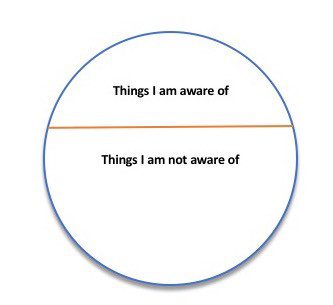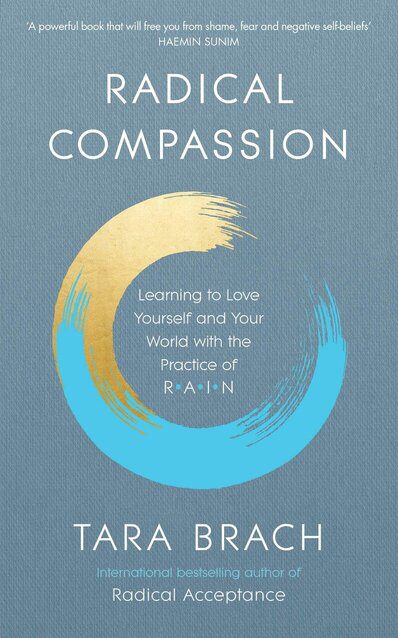Wisdom tells me I am nothing. Love tells me I am everything. And between the two, my life flows. – SRI NISARGADATTA
In Radical Compassion: Learning to Love Yourself and Your World with the Practice of RAIN, American psychologist and mindfulness teacher Tara Brach describes a four-step meditation practice for dealing with difficult emotions and limiting beliefs. Each step in the meditation practice are: Recognize, Allow, Investigate, and Nurture.
Brach is the author of one of my favourite books on dealing with trying times: Radical Acceptance: Awakening the Love that Heals Fear and Shame.
Favourite Takeaways – Radical Compassion by Tara Brach.
Radical compassion
Radical compassion means including the vulnerability of this life —all life—in our heart. It means having the courage to love ourselves, each other, and our world. Radical compassion is rooted in mindful, embodied presence, and it is expressed actively through caring that “inseparable dimensions of awakening. It depicts awareness as a bird with two wings: When both wings are unfurled in their fullness and beauty, the bird can fly and be free.
Do not try to save the whole world or do anything grandiose. Instead, create a clearing in the dense forest of your life. – MARTHA POSTLEWAITE
RAIN Practice
The name is an acronym that stands for the four steps of Recognize, Allow, Investigate, and Nurture.
- ORIGINAL VERSION OF RAIN (MICHELE MCDONALD): Recognize, Allow, Investigate, Non-Identification.
- CURRENT VERSION OF RAIN: Recognize, Allow, Investigate, Nurture.
It was originally introduced as a meditation guide by the senior Buddhist teacher Michele McDonald in the 1980s, and since then it has been adopted and adapted in various ways by mindfulness teachers.
RAIN cultivates the synchronistic power of mindfulness and heartfulness—both wings of awareness.
RAIN awakens mindfulness and compassion, applies them to the places where we are stuck, and untangles emotional suffering. RAIN creates a clearing in the dense forest, and in this clearing you can recover your full heart and spirit.
The first two steps of RAIN, Recognize and Allow, are the foundation of mindful awareness and compassion. The second two steps, Investigate and Nurture, deepen mindfulness and directly activate compassion.
Radical Compassion
Radical compassion expresses the truth of our interdependence and mutual belonging. Living true to ourselves becomes, in its fullness, living true to our collective path of healing and freedom, our shared yearning for a peaceful, loving world.
Living in Trance
We all get lost in the dense forest of our lives, entangled in incessant worry and planning, in judgments of others, and in our busy striving to meet demands and solve problems. When we’re caught in that thicket, it’s easy to lose sight of what matters most. We forget how much we long to be kind and openhearted. We forget our ties to this sacred earth and to all living beings. And in a deep way, we forget who we are.
This forgetting is a part of being in trance—a partially unconscious state that, like a dream, is disconnected from the whole of reality. When we’re in trance, our minds are narrowed, fixated, and usually immersed in thought. Our hearts are often defended, anxious, or numb. Once you recognize the signs of trance, you will begin to see it everywhere, in yourself and others.
You are in trance when you are living on autopilot, when you feel walled off and separate from those around you, when you are caught up in feeling fearful, angry, victimized, or deficient.
Taking a U-Turn
We are taking a U-turn whenever we shift our attention from an outward fixation—another person, our thoughts, or our emotionally driven stories about what’s going on—to the real, living experience in our body. It’s like being at a scary movie where we’re totally gripped by the story on the screen and then suddenly become aware: Okay, it’s just a movie.
Only by purposefully bringing attention to our inner experience can we move from trance toward healing. We need to become aware of the circling anxious thoughts, the habitual tightness in our shoulders, the pressure from being in a rush. Then we can begin to turn from our stories—about someone else’s wrongness, about our own deficiencies, about trouble around the corner—to directly feel our fears, hurts, and vulnerability, and ultimately the tender wakefulness of our heart.
The Circle of Awareness – Joseph Campbell
Above the line is everything we are conscious of, and below the line is everything outside our conscious awareness—a hidden world of fears, aversion, conditioning, and beliefs. To the degree that we’re living below the line, we’re in trance.
Being in trance is like being in a dream. We’re unaware that there’s a larger, living reality. And awakening from trance is like waking from a dream. We become self-aware, directly experiencing our inner life, the world we belong to, and the space of awareness itself. Living above the line is living in presence.
Presence has three primary characteristics: wakefulness, openness, and tenderness or love.
Everything above the line is in awareness, and everything below the line is not. When we resist fear, we are living partially below the line—identified with the fear, and cut off from our full lucidity and presence. Our unfelt, unprocessed fear is operating outside awareness to shape our beliefs, decisions, and actions. The fear we are unwilling to feel controls and binds our life.

The First Two Steps of RAIN
Mindfulness meditation, the Recognize and Allow of RAIN, trains us to wake up out of distracting thoughts and make the U-turn, bringing a full, embodied attention to our moment-to-moment experience. We inevitably encounter everything we’ve been avoiding—the loneliness, hurts, and fears. And yet if we practice regularly, we discover that we can maintain a balanced, openhearted presence in the midst of the storm
Between the stimulus and the response there is a space, and in that space is your power and your freedom. – VIKTOR FRANKL
Recognition
Recognition starts the minute you focus your attention on whatever thoughts, emotions, feelings, or sensations you are experiencing right now. The key question here is this:
“What is happening inside me?”
Recognizing is the first step of awakening from trance. It may take only a few moments, but it is crucial. You’re lifting your head above the waves of fear or anger; you’re becoming a witnessing presence.
Allowing
Allowing, the next step, asks you to “let be” whatever thoughts, emotions, feelings, or sensations you have just recognized. You initiate it by gently asking, “Can I be with this?” or “Can I let this be?” It’s natural to feel resistance at this point—you wish some of those feelings would go away! Allowing can include the reality of your “no”—the fact that you really hate the way you’re feeling.
THE TWO KEY QUESTIONS OF MINDFULNESS
Ask yourself, “What is happening inside me?”
“Now ask, “Can I be with this?” or “Can I let this be?”
Steps Three and Four of RAIN
I: Investigate with a Gentle, Curious Attention
Bring an interested and kind attention to your experience
N: Nurture with Loving Presence
Discover what best allows you to feel nurturing, what best allows the part of you that is most vulnerable to feel loved, seen, and/or safe. Spend as much time as you need, offering care inwardly and letting it be received.
Life is this simple: we are living in a world that is absolutely transparent and the divine is shining through it all the time. This is not just a nice story or a fable, it is true. – THOMAS MERTON
Our Negative Self-beliefs
Our most potent negative self-beliefs arise from early experiences of fear and wounding. Due to a survival-driven negativity bias, we remember painful events much more readily than pleasant ones. We remember the critical comment more than something affirming, the dog bite more than the beautiful sunset.
The brain is Velcro for negative experiences, but Teflon for positive ones. – Psychologist Rick Hanson
As long as we continue our fear-based thinking, our beliefs will maintain their potency. Our self-identity is reinforced by what others believe about us, and we collude by staying the same. We’d rather protect the current relationship than risk rocking the boat.
“It can be life changing to realize “I don’t have to believe my thoughts . . . they are just thoughts!”
Wisdom tells me I’m nothing. Love tells me I am everything. And between the two my life flows. – Sri Nisargadatta
The Fear of falling short
The fear of falling short is rooted in our survival brain, which has been shaping our existence for millions of years. This ancient fear keeps us holding on to the defensive skin of negative beliefs. Yet there’s also a powerful urge toward our full potential—an urge to emerge as a more integrated, intelligent, compassionate being.
Taking exquisite Risk
When we shed our old skin, when we loosen the protective covering of our convictions, when we step free from our negative beliefs about ourselves and others, we are taking what the poet Mark Nepo calls “the exquisite risk.” It’s a risk because, as with all growth, we are exposing ourselves to the unknown, to danger, and to loss. It’s exquisite because the natural beauty, sensitivity, and responsiveness of our being are awakened and revealed.
Men are only free when they are doing what the deepest self likes. And there is getting down to the deepest self! It takes some diving. – D. H. LAWRENCE
Chronic wanting keeps us from ever really arriving in the moment and seeing it as it is. When we’re always on our way somewhere else, we are not living the life that is here. RAIN helps to free us from the wanting that constricts our life.
When we’re in trance
We’re easily triggered by a tone of voice, an offhand comment, being kept waiting, a lack of attention. Our reaction is out of proportion to what is occurring, and we habitually assume that others are judging us, taking advantage of us, disrespecting us, or pushing us away.
Unreal Othering
Our attention focuses on their faults, their difference from us, on how they are threatening or impeding us. At the same time, our self-sense narrows and we become an Unreal Self—identified as a victim, identified as a victim, identified with our righteous anger. When the aperture of our attention contracts in this way, we are living below the line, unable to feel connected with others or at home with ourselves.
When we unconsciously perceive people as bad, Unreal Others, it’s easy to hurt them. We no longer see them as the subjective, feeling beings that we are.
THE GIFT OF FORGIVENESS
Both giving and receiving forgiveness are pure expressions of radical compassion. Both evolve us. When we open in forgiveness, we reconnect with our own openheartedness. When we feel forgiven, we are able to trust our belonging and our basic goodness. Like breathing in and breathing out, giving and receiving are interrelated: Both allow us to remember and live from the gold.
“It never hurts to think too highly of a person; often they become ennobled and act better because of it.” – Nelson Mandela
Implicit bias
“Implicit bias” is the scientific term for the unconscious or semiconscious ways we stereotype individuals or groups, depending on our social conditioning. Early mindfulness researchers proposed that a key impact of mindfulness practice is the reduction of automatic processing.
The Empathy Trap
Empathy is our capacity to feel the emotions of others and/or take the perspective of other people. But therein lies a trap: If we become too distressed by their suffering, we may not have the cognitive or emotional resources to help them.
Compassion
Compassion begins with empathy, but the crucial element of mindfulness protects us from merging or identifying with the pain. Empathy alone can lead to burnout, but the mindfulness and care inherent in compassion foster resilience, connectedness, and action.
Four Remembrances: Pause for Presence, Say Yes to What’s Here, Turn Toward Love, Rest in Awareness
To be kind, you must swerve regularly from your path.
PAUSE FOR PRESENCE
Pausing for presence begins in RAIN when we Recognize and Allow what is here, and stop pedaling. We are learning to let go of the habitual controls—of all our strategies for avoiding unpleasantness and discomfort, and grasping after pleasure.
SAY YES TO WHAT’S HERE
Saying yes expresses our heart’s wisdom. Only when we open to reality as it is—without any resisting or grasping—can our heart and intelligence come fully alive. Only by saying yes to this moment can we respond to our own life and the lives of others with the courage of radical compassion.
TURN TOWARD LOVE
Set your intention to turn toward love when you become aware of feeling lonely, depressed, anxious, caught in self-judgment, or blaming others. Give yourself permission to experiment with different ways of reconnecting with love.
REST IN AWARENESS
It is during this time of non-doing that we directly experience the openness, wakefulness, and tenderness of our true nature. These moments can reveal the formless radiance of consciousness itself, the essence of who we are.
We sow the seeds of radical compassion when we pause and say yes to what’s here; when we turn toward love and rest in awareness. This cultivates the presence that guides us in living from compassion, in living true to our awakened heart.
All the Best in your quest to get Better. Don’t Settle: Live with Passion.



Comments are closed.